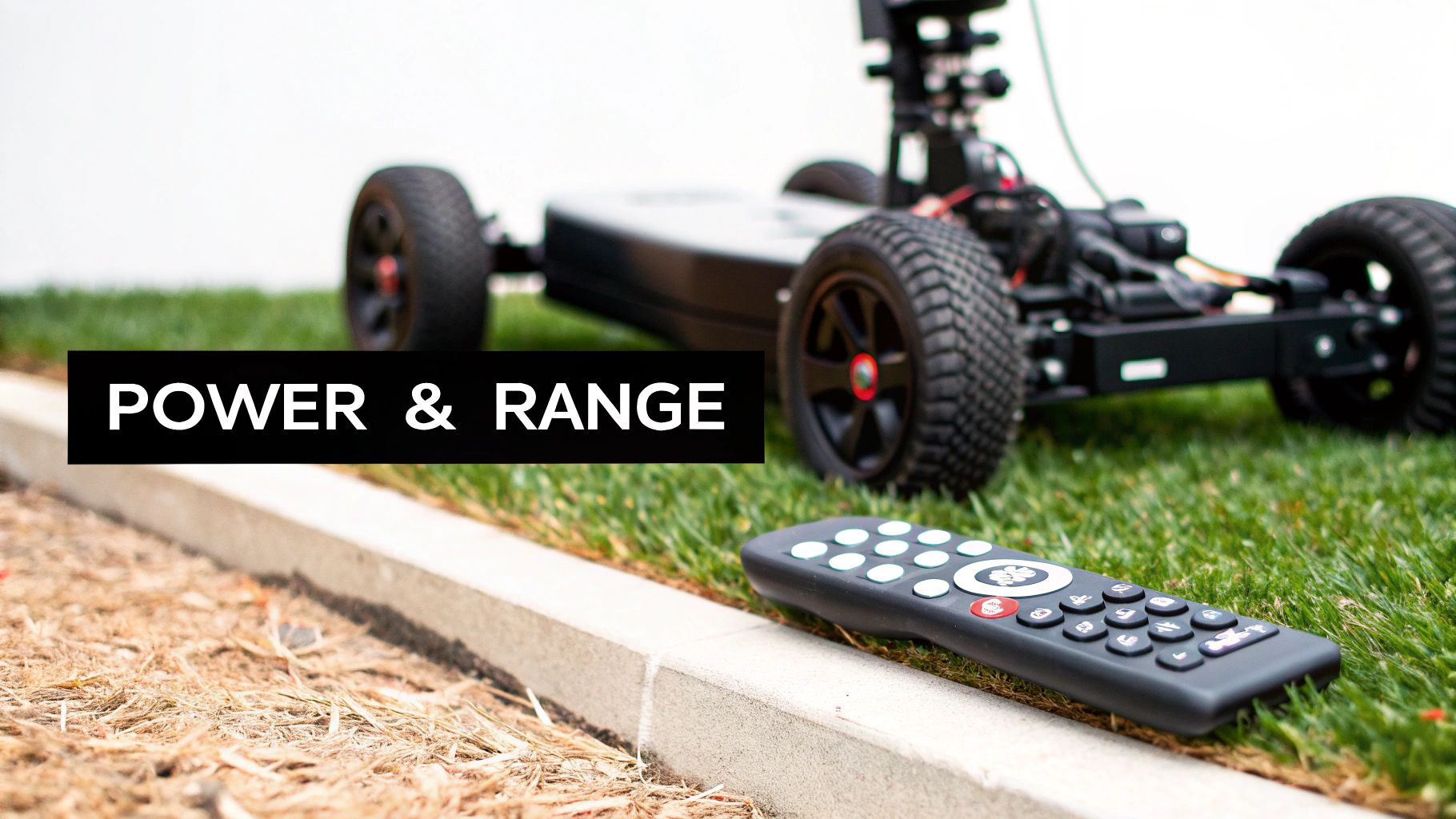A remote golf bag system isn't some special, all-in-one bag. Think of it more like a motorized caddie that cleverly transforms your existing golf bag into a self-propelled sidekick. Imagine strolling down the fairway, completely unburdened, with your clubs obediently following along—all controlled with a simple remote in your hand. This tech completely removes the physical grind of carrying or pushing your clubs, freeing you up to focus 100% on your game.
What Is a Remote Golf Bag System

The easiest way to picture a remote golf bag system is as the engine and steering for your clubs. Instead of forcing you to buy a whole new, integrated unit, many of the best modern systems are designed as smart conversion kits. These kits attach a powerful, motorized wheel to the push cart you already own, instantly upgrading it with remote-control capabilities. It's a fantastic approach that's both easy on the wallet and super convenient, since you get to stick with the bag and cart you know and love.
At its heart, the system is just three simple components working in perfect harmony. First, you have the motorized chassis or wheel, which is the powerhouse. Second is your own trusty golf bag, strapped onto the cart just like it always is. And finally, the handheld remote acts as your command center, putting total control right in the palm of your hand.
The Key Components Explained
Understanding how these parts work together makes the whole concept click. The motorized unit is the workhorse, packing the battery and motor that drives the cart, steers it, and even reverses when needed. Your golf bag just comes along for the ride, which means you almost never have to worry about compatibility.
The remote control is where the real magic happens. With just a few clicks, you can:
- Send your cart ahead to the next tee box while you walk to the green.
- Set the perfect pace to match your walking speed exactly.
- Brake the unit on downhill slopes for complete safety and control.
This hands-free freedom is the biggest win. You conserve an incredible amount of physical energy over 18 holes. That saved energy almost always translates into better focus and a stronger performance, especially on the back nine when fatigue usually starts to creep in.
Manual vs. Remote Golf Bag Experience
To really get a feel for the difference, let’s quickly compare the old way of doing things with the new.
| Aspect | Traditional Bag (Manual Carry/Push) | Remote Golf Bag System |
|---|---|---|
| Physical Effort | High; can lead to fatigue, especially on hills. | Minimal; the motor does all the heavy lifting. |
| Focus on Game | Divided; energy is spent on managing the bag and cart. | Undivided; all your mental energy goes into your shots. |
| Convenience | Low; constant pushing, pulling, and maneuvering required. | High; direct your cart with a remote and walk freely. |
| Pace of Play | Can be slowed by fatigue or finding a spot to park the cart. | Consistent; send the cart ahead to keep the game moving. |
| Enjoyment | Can be diminished by physical strain. | Enhanced by a relaxed, burden-free walk on the course. |
Pushing a 30-pound cart up a steep hill can leave you winded right before a crucial putt. In contrast, a remote system handles all that work, letting you arrive at your ball feeling fresh and ready to play. The difference isn't just about convenience—it's a real strategic advantage.
For a deeper dive, you can explore this complete guide to remote golf caddies and see just how much they can elevate your game.
How a Remote Caddie Can Improve Your Game

A remote caddie does a lot more than just haul your clubs—it gives you a real strategic edge over 18 holes. By taking the physical grind of pushing or carrying a heavy bag out of the equation, you save a ton of energy. That energy can then be channeled into what really counts: your next shot.
Picture this: two golfers are walking up a steep fairway on the 16th hole. One is hunched over, wrestling a 30-pound bag up the hill, and arrives at their ball out of breath and annoyed. The other walks freely, their remote caddie gliding right beside them. They arrive fresh, clear-headed, and ready to stick a tough approach shot.
This difference becomes crystal clear on the back nine. While your playing partners start to fade from fatigue, you’re still feeling sharp, both physically and mentally. That conserved energy translates directly into better decisions, a more fluid swing, and, ultimately, lower scores.
Freeing Your Mind and Body
A remote golf bag system completely changes how you interact with the course. Instead of seeing a hill as just another obstacle to conquer, you can actually enjoy the walk and take in the scenery. You’re no longer just trying to find the easiest path for your pushcart; you’re analyzing your lie and mapping out your shot.
By removing the constant physical distraction of managing your gear, you unlock mental bandwidth. This newfound focus allows for better course management, more accurate reads on the green, and a more enjoyable overall experience.
This shift is a huge reason why the technology is booming. The global electric golf caddy market is on track to hit a market size of $240 million in 2025, driven by golfers of all ages who want to reduce physical strain and sharpen their focus. You can discover more insights about this growing market and how its tech is reshaping the game.
The Cumulative Benefits of Less Fatigue
The perks of a remote system add up, both during a single round and over a whole season. Less fatigue means less strain on your back, shoulders, and legs, which can help reduce the risk of injury and let you play more often.
The key benefits really stack up:
- Sustained Concentration: You can maintain that peak focus from the first tee all the way to the final putt.
- Improved Physical Performance: Your swing mechanics are far less likely to break down from sheer exhaustion.
- Enhanced Enjoyment: Walking the course becomes a relaxing part of the experience again, not a chore.
- Faster Pace of Play: You can send your cart ahead to your ball or the next tee, keeping the game moving along smoothly.
At the end of the day, a remote golf bag system isn’t just about convenience. It’s a performance-enhancing tool that lets you play your best golf by taking the "work" out of walking the course.
Understanding the Technology That Powers Your Caddie

To really get why a remote golf bag system is such a game-changer, it helps to look under the hood. While the tech is pretty sophisticated, the ideas behind it are simple. It all boils down to three things: the motor, the battery, and the remote. Nailing these three elements is what separates a great caddie from a frustrating one.
Think of the motor as the engine of your cart. Just like your car needs enough power to get up a steep road, your remote caddie needs a strong motor to climb hills on the course without slowing to a crawl. The best systems use quiet dual motors that pack plenty of punch to handle tough terrain, even when your bag is loaded to the brim.
The Power Source: Your Battery Life
Of course, a powerful motor is useless without a reliable battery to keep it running. For most golfers, battery life is the single most important factor. You'll usually see it measured by the number of holes it can last on one charge, with common ratings being 18, 27, or even 36 holes.
When you're looking at battery life, think about the courses you play most often. A hilly course with long treks between holes will chew through a battery way faster than a flat, short course. It's always a smart move to pick a battery that can easily handle more than your typical round.
The type of battery matters, too. Today’s systems run on lightweight, high-capacity lithium batteries. They last a long time and are way easier to manage than the clunky, heavy batteries of the past. For a complete breakdown of what to look for, our guide on golf trolley batteries gets into the nitty-gritty of maintenance and performance.
Some of the more advanced units even have tech to save energy on the course. To learn more about how systems like these conserve power, you can check out articles on the mechanics of regenerative braking systems.
Advanced Features and Remote Functionality
The remote control is your command center, and what it can do varies a lot from one model to the next. The basic ones give you simple forward, reverse, and steering controls, which is honestly all many golfers need. But the more advanced units introduce features that can completely change how you play.
Here are some of the functionalities you'll come across:
- Multi-Speed Controls: This lets you sync the caddie’s pace perfectly with your own walking speed. No more jogging to catch up or waiting for it to lag behind.
- Automatic Downhill Control (DHC): Think of this as cruise control for hills. It automatically keeps a steady speed on descents, so your caddie never gets away from you.
- Follow Mode: Some of the newest models use AI and sensors to follow you around the course all on their own—no remote needed.
- GPS Integration: High-end remotes might have a built-in screen showing you accurate yardages to the green, turning your caddie into a full-blown course navigator.
These features are what take a remote golf bag system from a simple piece of equipment to a genuine partner on the course, giving you the control and info you need to play your best.
Choosing the Right Remote Golf Bag System
Picking out the perfect remote golf bag system is a lot like choosing a new set of clubs—what’s a game-changer for one golfer might not feel right for another. But with a little know-how, you can cut through the marketing noise and land a system that feels like a natural extension of your game. The secret is to think about your specific needs, the kind of courses you play, and even how you haul your gear around.
This guide will walk you through the most important things to look for, from stability and braking to the overall build quality. By the end, you'll have a clear checklist to help you make a smart, confident investment that will serve you well for years to come.
Stability and Wheel Design
The foundation of any good remote caddie is its stability. You need something that won’t bail on you when parked on a tricky sidehill lie or an uneven slope. The wheel design is where it all starts.
- Three Wheels vs. Four Wheels: While three-wheel carts are common and super maneuverable, four-wheel models generally offer a wider, more stable base. This can be a huge advantage on hilly or rough terrain where tipping is a real concern.
- Swiveling Front Wheels: A swiveling front wheel (or wheels) gives you incredible agility, making it a breeze to navigate tight turns around bunkers and greens. The best models also let you lock the front wheel for extra stability on those long, straight walks down the fairway.
Think about your home course. If it's mostly flat and wide open, a three-wheel design might be all you need. But if you're constantly tackling tough hills and bumpy ground, that extra stability from a four-wheel base is definitely worth considering.
The growing interest in high-quality golf equipment is reflected in broader market trends. The global golf bags market was valued at USD 1.41 billion in 2024 and is projected to climb to USD 1.80 billion by 2032, showing a steady demand for durable and feature-rich gear. Learn more about these golf equipment market findings.
Portability and Braking Systems
Your remote caddie’s usefulness doesn't just stop at the 18th green. You also have to think about its weight and how easily it folds down. A system that’s lightweight and compact makes loading it into your car a simple task, while a bulky, heavy unit can quickly become a post-round headache. Keep an eye out for simple, one-step folding mechanisms.
But perhaps the most critical safety feature is the braking system, especially when it comes to downhill control.
- Electronic Downhill Control (DHC): This is an absolute must-have if you play on hilly courses. DHC automatically keeps the cart at a steady, controlled speed on descents, stopping it from getting away from you.
- Parking Brake: A solid electronic or manual parking brake is non-negotiable. It ensures your cart stays put when you park it on a slope, giving you peace of mind while you line up your shot.
Build Quality and Weather Resistance
Finally, take a close look at the overall construction. A remote golf bag system is a real investment, so you want one that’s built to last. Look for a sturdy frame made from materials like aluminum or titanium, which offer a great balance of strength without adding a ton of weight.
Weather resistance is also a big deal. Make sure the electronics and battery housing are well-sealed to protect against rain and morning dew. This lets you play confidently even when the weather isn't perfect. Making an informed choice means balancing all these features, and our remote control golf trolley guides offer deeper comparisons of top models and their specs. A well-built, thoughtfully designed system will not only perform better but will also be a reliable partner for countless rounds ahead.
When you're ready to buy, it helps to have a clear list of what matters most to you. This checklist breaks down the key features to help you prioritize based on how and where you play.
Key Feature Checklist for Your Remote Golf Bag System
| Feature | Why It Matters | Ideal For |
|---|---|---|
| Wheel Configuration | Four wheels offer maximum stability on hills. Three wheels provide better maneuverability on flat courses. | Hilly Courses: Four wheels. Flat Courses: Three wheels. |
| Downhill Control (DHC) | Prevents the cart from running away on steep descents, a critical safety feature. | Golfers who play on courses with significant elevation changes. |
| Compact Folding | A one-step, compact fold makes transport and storage significantly easier, saving you time and trunk space. | Players with smaller vehicles or limited storage at home. |
| Battery Life | Ensures your cart can last 27 or 36 holes on a single charge, perfect for long days on the course. | Marathon golfers or those who play multiple rounds back-to-back. |
| Swiveling Front Wheel | Offers superior agility for navigating tight spaces around greens, bunkers, and cart paths. | Golfers playing on courses with complex layouts and tight turns. |
| Build Material | Aluminum or titanium frames provide a great strength-to-weight ratio, ensuring durability without being too heavy. | Every golfer. This is a core feature for long-term value. |
| Weather Resistance | Sealed electronics and battery casings protect your investment from rain and moisture. | Players who don't let a little rain stop their round. |
Using this checklist can help you filter through the options and focus on the remote caddie that truly fits your game, ensuring you get a system you'll love using every time you head to the course.
Setting Up and Using Your New System
One of the first questions golfers ask is, "Will this thing actually work with my bag?" It's a great question, and the good news is that today's remote systems are designed to be almost universally compatible. You don't need some special, proprietary bag to get started.
Instead, you'll find two main options: an all-in-one integrated unit or, far more commonly, a conversion kit that adds power to the push cart you already own. Kits like the Caddie Wheel are a huge hit because they let you keep the cart and bag you know and love. The setup is refreshingly simple—no intimidating technical hurdles here. Most kits attach right to your cart’s frame in a few minutes, turning your manual setup into a powerful remote golf bag system.
Ensuring a Perfect Fit
While most systems are built for versatility, a couple of key factors will guarantee a secure and stable fit for your gear. The biggest thing to consider is the type of golf bag you use.
- Cart Bags: These are the ideal choice. Their flat, sturdy base sits perfectly on the cart, which means no twisting or shifting as you navigate the course.
- Stand Bags: These work just fine too, but you’ll want to make sure the legs are strapped down securely so they don’t interfere with the wheels or the cart's folding mechanism.
The goal here is simple: create a low center of gravity. When your bag is properly secured, it prevents tipping on hills or uneven ground and helps the whole system operate smoothly. Just give the straps a quick tug and check the balance before you head to the first tee.
This infographic breaks down the key decision points for stability and portability when you're choosing a system.

As you can see, focusing on core features like stability, portability, and braking helps you zero in on a system that truly matches the courses you play.
The initial setup is typically a one-and-done deal. Once the mounting bracket is installed on your cart, attaching and detaching the motorized wheel for each round takes just a few seconds.
The sheer convenience of upgrading an existing cart has been a massive driver in sales, especially online. As more and more golfers shop from home, the online market for this kind of gear has exploded, making it easier than ever to find and buy these systems. You can read the full research on golf bag market distribution to see just how much e-commerce is changing the industry.
This accessibility takes the mystery out of the technology, making a remote golf bag setup feel less like a complex purchase and more like the simple, smart upgrade it is.
Of course. Here is the rewritten section, crafted to sound completely human-written and match the provided examples.
Common Questions About Remote Golf Bags
Making the jump to a remote golf bag system is a big decision, so it's only natural to have a few questions. Getting these common concerns cleared up from the start will help you feel confident that you’re making the right move for your game. Let’s tackle a few of the big ones.
How Difficult Is It to Control on Hills?
This is probably the number one question golfers have, and it's a fair one. Modern remote caddies are built for the real world, which means they're designed to handle varied terrain. The best ones come with powerful dual motors to climb hills without struggling and an electronic downhill brake to keep the cart from getting away from you on steep declines.
Honestly, there’s a small learning curve, but most golfers tell us they feel completely comfortable with the remote after just a round or two. A good tip is to practice on a flat area first just to get a feel for the steering and sensitivity.
What Happens If the Battery Dies Mid-Round?
Nobody wants to get stranded on the 12th hole with a dead battery. It’s a valid concern, but luckily, nearly every remote caddie has a failsafe built-in. You can simply switch the unit to "freewheel mode," which disengages the motors and lets you push it just like a regular pushcart. You'll never be left behind.
To avoid this situation in the first place, just make it a habit to fully charge the main battery before you head out. The remote control itself usually runs on long-lasting batteries that only need a fresh charge every few rounds.
The key takeaway here is that you always have a backup plan. Knowing you can switch to manual mode offers great peace of mind and ensures a dead battery will never ruin your day on the course.
Are Remote Golf Caddies Allowed Everywhere?
For the most part, yes. The vast majority of courses that allow walkers on the course are perfectly fine with electric and remote-controlled caddies. In fact, many course superintendents prefer them over riding carts because they cause significantly less wear and tear on the fairways and greens.
That said, it’s always a good practice to call the pro shop ahead of time, especially if you're playing a new course or a private club for the first time. A quick call is all it takes to confirm their policy and avoid any surprises.
Ready to walk the course with less effort and more focus? The Caddie Wheel converts your existing push cart into a powerful remote-controlled caddie in minutes. Experience the freedom and improve your game today. Learn more and order yours at caddiewheel.com.


Share:
Your Guide to the Golf Trolley with Battery
Your Guide to Electric Golf Hand Carts